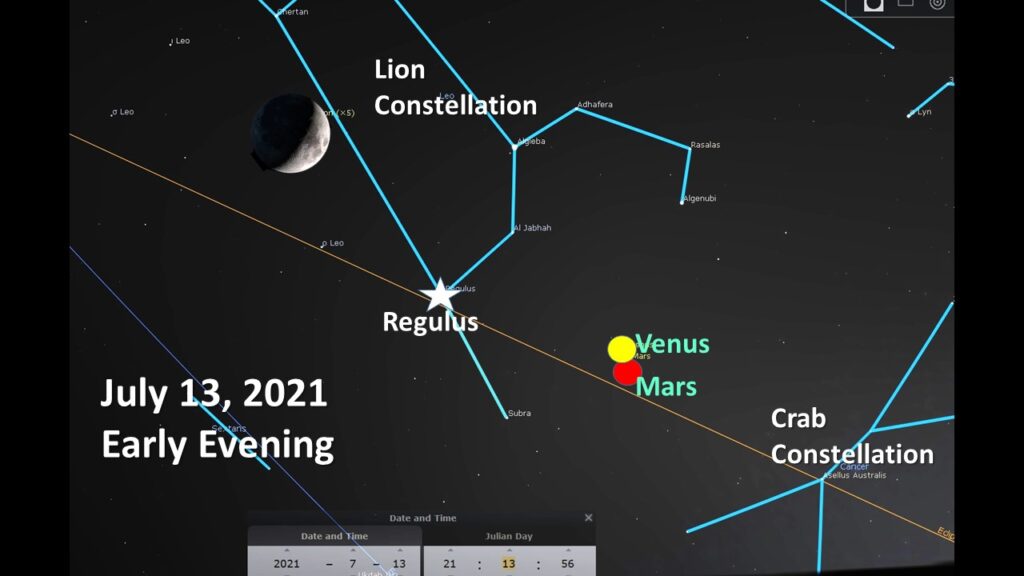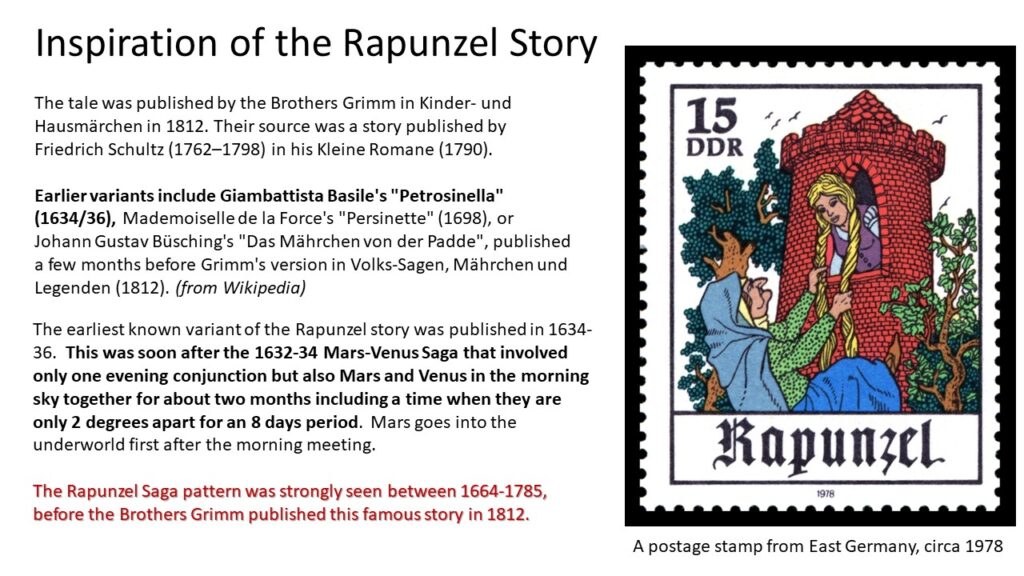The Ongoing Celestial Dance of Mars and Venus
The planets Mars and Venus figure prominently in the early evening sky for the whole month of July. These two planets have a natural pattern that can be seen regularly over long periods of time. This year, we humans get to experience the first visible conjunction since 2017 and the first actual conjunction since 2019. This year, the conjunction and dance takes place in the sign of Leo, but in very different phases in their respective cycles.
Venus is currently continuing its ascent into the sky, gaining more separation from the Sun as we get further along in the summer season. Venus also continues to brighten from -3.9 in July and will reach near its maximum magnitude at -4.9 in early December. Mars, on the other hand, is reaching near its lowest point of visibility as it orbits farther away from Earth at +1.8 magnitude in July and August to disappearing altogether in the glare of the Sun on August 22-23.
This pattern of Mars and Venus generally repeat every 6 ½ years (3 full synodic cycles of Mars), with the Mars synodic cycle representing the boundaries that define the Mars-Venus pattern. This pattern has inspired global mythological stories for many thousands of years from ancient Sumer to 17-19th century Europe. What are those boundaries and what is Venus’ pattern in relation to Mars? And why is this dance the inspiration of stories?
Learn more about the Mars-Venus Saga in new webinar from Daniel Giamario and Erik Roth here
On average, every 780 days (or almost 26 months), Mars returns to the same position (not in the same place in the sky with the same star backgrounds or season) in its relationship to the Sun as seen from Earth. In shamanic astrology, the moment of the Mars-Sun opposition (akin to the Full Moon for Mars) is the start and end moments of the Mars synodic cycle. In this nearly 26-month period, Venus and Mars conjunct at least once and up to a maximum of three times.
The current Mars-Venus dance involves three conjunctions in the 26-month period from the most recent Mars-Sun opposition on October 13, 2020 to the next one on December 7, 2022. One of those conjunctions occur on July 13, 2021 and the other 2 take place in 2022 in the early morning skies. This specific time period is known as the Dumuzi-Rapunzel Saga, coined by Daniel Giamario’s original research in the 1990s.
While this is one of 6 distinct “sagas”, (meaning Mars-Venus patterns in a 26-month period), it was present during the Renaissance period in the 17th and 18th centuries. This pattern strongly linked to the original stories that inspired one of the most well-known stories that Brothers Grimm wrote in 1812, a “fairy tale”, called Rapunzel.
The other character that is strongly linked to the pattern is named Dumuzi, a shepherd-king god who managed to convince the Goddess-Queen of Heaven and Earth, Inanna into marriage. An ancient story from about 4,000 years ago, “The Courtship of Inanna and Dumuzi” is symbolized by the “courtship” of the planets Mars and Venus in the sky.
There are other patterns of Mars and Venus that connect us to other stories of the feminine and masculine which live on in contemporary times, especially in the various mediums in which we consume on a regular basis.
Over time, these regular patterns of Mars and Venus evolve into other patterns, then repeat over the centuries. The last time this pattern revealed itself in the sky was in 2014-16 with only 2 visible conjunctions, one in the morning and one in the evening. But due to the sheer amount of time (94 days) Mars and Venus were within 10 degrees (experientially a conjunction) in the morning skies, this was also part of the evolving story-pattern.
Much of this theme of the masculine and feminine principles coming together in varying ways itself has evolved as well due to significant changes in cultures and perceptions of men and women. The story of Dumuzi and Inanna has a different context, cultural projection to reach the “happily ever after” outcome compared to the Rapunzel story.
We can consider that Rapunzel and the prince have their initial meeting in the morning sky where they fall in love, then Mars surrenders to the underworld, a time of soul-searching and shamanic death/rebirth until hearing the voice of Rapunzel again some time after where there is a longer meeting in the morning. Presumably, Rapunzel experiences a metamorphosis in the time the prince is “in the underworld or time of surrender and loss”.
In the Dumuzi-Inanna story, the “underworld” portion is linked to the stories, The Descent of Inanna and The Dream of Dumuzi in which Inanna has risen from the underworld and chooses to have Dumuzi replace her. But later, Dumuzi returns to the heavens to be with Inanna after his time spent in the underworld. In all of that the prominent “masculine” figure is Dumuzi or Tammuz (Akkadian version of Dumuzi).
The stories are a reflection of the words, “as above, so below,” and our own cultural projections of the masculine and feminine at the time as well as a little imagination. When we follow the planets across the sky regularly, we can open to these stories previously written or being written within ourselves. From the perspective of being on Earth (known as “geocentric”), the planets meet at times, separate, cross starry constellations, connect with the Moon and disappear in glare of the Sun. Each of them experience their own individual patterns as well as patterns with each other.
The sky has been a living thing for most of our history and is reflected in our stories and myths. Mars and Venus are sharing something intimate with us as we gaze into the early evening sky this month. The sign of Leo, which both are transiting, activates radical, radiant self-love and the creator-matrix and alchemy of both the masculine and feminine principles. But Mars is fading in its light in preparation for its surrender to the underworld while Venus re-claiming her power (brightening in the sky in the second half of the year) after her rebirth into visibility in early May of 2021.
In the Rapunzel story, this means the prince has leapt from the sorceress’s tower where Rapunzel lives, trying to commit suicide in despair and goes blind from the thorns he tangles with on the way to the ground. He thus wanders for a while in the story, unable to see. The planet Mars is hidden in the glare of the Sun and “can’t see” Venus anymore. Rapunzel is pregnant and gives birth after herself being thrown out by the sorceress, not knowing her prince is still alive.
In Dumuzi’s case, he is being escorted to the underworld by demons sent by Inanna’s sister, Erishkigal in order to fulfill the replacement of Inanna (since no one is allowed to leave, an arrangement of sorts is made after Inanna is reborn and returns to her heavenly kingdom). But this is only after attempts by Dumuzi to flee before being captured. At the end, he surrenders to his fate.
These two portions of the stories are just samples of the how the sky influences us and tells us about ourselves. If we study other stories like these there would likely be found significant correspondences with the patterns in the sky. Here are some other examples in history:
- The Lakota Sun Dance and Mandan Okipa/Okeepa Ceremonny
- A Hero’s entering into the “belly of the whale” (the whale being an analogy to the underworld and feminine). Raven of the Eskimo and Jonas and the Whale are good examples
- The Death/Rebirth Myth of the Egyptian god, Osiris, who was killed by Seth (brother) and then revived by the goddesses Isis (partner/lover) and Nephthys (sister)
- The story of Izanagi (hero-god-king) and Izanami (sister-wife) from Japanese mythology
- The Myth of Nergal/Erra (pre-cursor to Mars) and Erishkigal (from 1500 BC Mesopotamian)
- Modern Pop Culture example of the story of the Dark Knight (Batman) and his commitment to serve in the underworld in order to re-claim himself and literally climb out of the depths of the earth
I encourage others to take a look at the stories and to gaze into the skies and follow the planets. We all have a relationship with them. Shamanically, they act as spirit guides for our soul’s journey and we can more fully participate in our lives by knowing our own emerging story.

